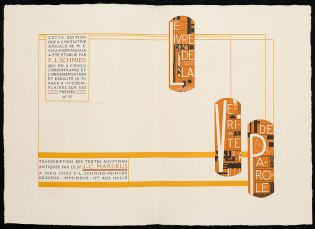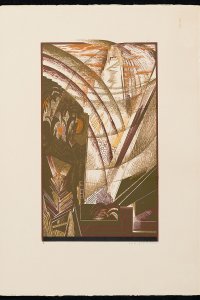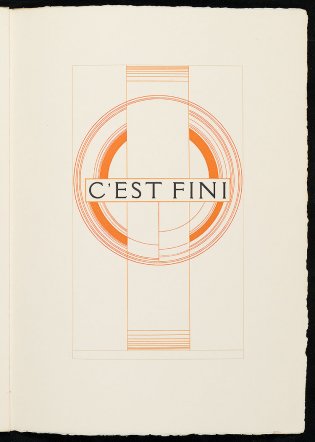Le livre de la vérité de parole
Year: 1929
Author: Joseph-Charles-Victor Mardrus (1868 - 1949)
Artist: François-Louis Schmied (1873 - 1943)
Publisher: F.-L. Schmied
François-Louis Schmied received great praise following the publication of Daphné (1924). In the very same year, the Art Deco engraver, illustrator, typographer, printer, bookbinder and publisher befriended doctor, orientalist and translator Dr. Joseph-Charles Mardrus. Colonialism and Orientalism were at their very peak at this time. Schmied and Mardrus shared a strong sensitivity to literature, which guaranteed their harmonious collaboration. Mardrus translated the Tales of 1001 Nights into French and also supplied Schmied with the translation of the ancient Egyptian texts from Le livre de la vérité de parole for this book. It was a book of the dead, in which every chapter begins, like a doorway to eternity, with the incantation 'O, shapes of eternity, here I am' ('O formes d'éternité me voici'). They are accompanied by Schmied's graphic memorial stones.
Ambition, dedication and perfectionism
Schmied came to Paris in 1895 as a young Swiss art student. With great difficulty he managed to find his way as a budding artist through the overwhelming cultural jungle of the Fin de Siècle. The young Schmied succeeded in escaping from the destiny his father, who cultivated decorative plants, had ordained for him as his successor. He could now dedicate himself fully to books as works of art. He took drawing lessons between six and eight o'clock in the morning before taking up his daily duties. As soon as he was finished working, he took up his drawing pen once again between eight and ten o'clock in the evening. During his studies at the École des Arts Industriels in Geneva, Schmied had come to distinguish himself in the art of wood engraving due to his boundless ambition, dedication and perfectionism. His predilection for books was increased further by inspirational teacher Alfred Martin and by Auguste Lepère, one of the first book artists. In order to develop his love further, Schmied also gathered inspiration from old manuscripts, incunabula and sixteenth-century editions from Lyon, which was the main producer of early editions besides Paris.
Atelier Schmied heyday
After a long period of hardship and hard work, Schmied finally found some measure of success. His son Théo came to assist him in his studio. The collaboration with artists Dunand, Goulden and Jouve contributed to their success. They exhibited their work together as a foursome at the Galerie Petit, which led to many new commissions, especially for Schmied. But after moving from a little attic room to a stately four-storey mansion in 1922, the omnivorous artist now had access to a fully equipped studio. Schmied's craftsmanship in all areas of the art of book printing had created unprecedented possibilities for his studio. This came to full expression mainly in combination with his predilection for Romanesque stories draped in fantastical stages, while his social connections to artist friends, apprentices and associates contributed to the heyday of the Atelier Schmied. The fact that Schmied lost an eye during his military service in World War I did not have any effect on this.
Book architecture
The sketches for this edition of Le livre de la vérité de parole were exhibited in 1926 in Galerie Petit. The book was printed by Schmied's apprentices and his son Théo. The large number of passes through the press that were necessary for the complex composition of the different text colours, illustrations and decorations took up a great deal of time. Because of this, the book was not published for another three years. The influence of medieval and Renaissance 'book architecture' that shines through in Le livre de la vérité de parole can be recognized in the initials, ornaments and decorative fields that make Schmied's artist's book so beautiful and so valuable.
-
Colour woodcut I, signed by F.L. Schmied
-
Colour woodcut by F.L. Schmied (page [33])
-
Colour woodcut XII, signed by F.L. Schmied, and facing text page (pages [118]-[119])
Bibliographical description
Description: Le livre de la vérité de parole / transcription des textes Égyptiens antiques par J.-C. Mardrus ; établie par F.-L. Schmied – Paris : F.-L. Schmied, 1929 – [103] p., [12] bl. pl. : ill. ; 35 cm
Printer: F.-L. Schmied (Paris)
Edition: 150 copies
This copy: Number 57 of 150 on Arches filigrané
Note: In publisher's slipcase
Bibliography: Bénézit 12-472 ; Carteret IV-264 ; Prout II-29-07
Shelfmark: KW Koopm K 389
References
- Danielle Buyssens, François-Louis Schmied: Le texte en sa splendeur. Lausanne, La Bibliothèque des arts, 2001
- Anne Bony, 'L'Atelier Schmied', in: Art et Métiers du livre, 177, (1993), p. 2-35
- Paul van Capelleveen, Sophie Ham, Jordy Joubij, Voices and visions. The Koopman Collection and the Art of the French Book. The Hague, Koninklijke Bibliotheek, National Library of the Netherlands; Zwolle, Waanders, 2009
- Paul van Capelleveen, Sophie Ham, Jordy Joubij, Voix et visions. La Collection Koopman et l'Art du Livre français. La Haye, Koninklijke Bibliotheek, Bibliothèque nationale des Pays-Bas; Zwolle, Waanders, 2009
- Raymond Hesse, Le livre d'art du XIXe siècle à nos jours. Paris, La Renaissance du Livre, 1927


![Kleurenhoutsnede door F.L. Schmied (p. [33])](/sites/default/files/styles/galerie/public/images/le-livre-de-la-verite-de-parole-p33.jpg?h=383fc4a2&itok=xym9UevU)
![Kleurenhoutsnede XII, gesigneerd door F.L. Schmied, met tegenoverliggende tekstpagina (p. [118]-[119])](/sites/default/files/styles/galerie/public/images/le-livre-de-la-verite-de-parole-p118-119.jpg?h=383fc4a2&itok=hHawk24M)
